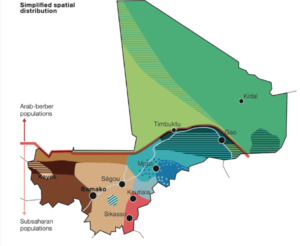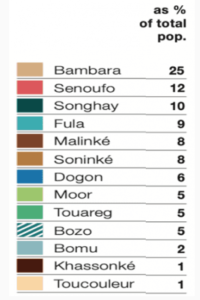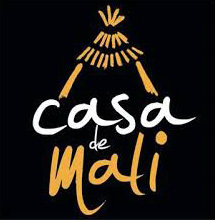MALI
-
![]()
Mali has a surface area of 1.240.192 km2 and has a hot and dry climate, with a semi tropical climate in its southern region. Its capital is Bamako. Our association works mainly in the Djélibani village, near Siby.
-
![]()
Its population reaches 19.080.000 inhabitants and is formed by various ethnic groups: (OECD, 2015).
CURIOSITIES OF SOME ETHNIC GROUPS
- Bambara: residential, productive and political unit is patriarchal and patrilocal. The eldest male is called dutigi and lives with their extensive family. Their art comes from the different artistic traditions. The Bambara sculpture is more complicated than the Dogon sculpture, which is more austere and with less decoration. Each society has their own masks, ridges and puppets. Masks are used during celebrations: matrimonies and inaugurations of a market. The youth dance during the parties and demonstrate their aptitude to gain prestige by asking the village elders for permission.
- Senoufo: They speak more than 30 dialogues. They’re very skillful in agriculture, cultivate dry rice, yams, peanuts and millet in the prairies within its zone. For a male to gain popularity and prestige in the village, he has to become a sambali (champion cultivator). A sambali is respected for their entire life and defends the honor of their residence in front of the entire town and district.
- Songhai: The Songhais are originally from the Dendi region, what now is the southern region of the Niger Republic and the northern region of the Benin Republic. Historically they were known for making long journeys to sell their salt and gold. Later on they converted to farmers, fishers and expert merchants. The majority of the Songhai people practice Islam and divorce is common among them. The male initiales the separation through a formal consultation with the muslim clergy and proclaiming it three time. However, women initiate divorce informally by leaving their spouse, and he proclaims it after the woman has left. All the Songhai celebrations are filled with music, dances and poetry. These actions are done by the jelis, both women and men.
- Fula: The Fulani are nomad people whose origin isn’t accurately known. They were the first ethnicity west of Africa to adopt Islmal as their religion and extend it throughout the region. They are traditionally nomad pastors and merchants. Their beauty and care stands out among the Fulani. Socially, for an African to have Fulani ancestors is synonymous to distinction and prestigious inclusion.
- Malinké: The Malinkés live in rural zones, but can also be found in the Bamako capital. Between the XVI and XIX century many of them were slaves of Malinké origin. According to recent studies, the inhabitants of African origin in Brazil, South of the United States of America and the Caribbean have Malinké descendents. Majority of them were poor farmers who struggled with hunger during rainy seasons. The Malinké women are the womens who do the more physical tasks and hunt, such as taking care of the rice camps, in addition to taking care of their kids. They have an immense oral tradition where the jelis maintain their village’s histories alive and are accompanied by the sound of the kora, a traditional instrument.
- Soninké: They are considered the founders of the Ghana empire (s.VIII), but when it was dissolved, diasporas were created in Senegal, Mali, Mauritania and Gambia. They are considered really good merchants, known as ‘les colporteurs de l’Afrique Occidentale’. Their culture was influenced by Islam, though they continue to maintain a strict bond with their more traditional culture.
- Dogon: The Dogon people are famous for developing their own cosmology and liking rituals to it. Their mask dances have been converted to a tourist attraction. In their more dramatic rituals, like funerals, the masks offer the spirits a last glimpse of the living world. When the mask has been used, it is considered no longer sacred and sold to tourists. They’re also known for their sculptures. The Dogon sculptures are not created to be shown in public and are commonly stored in homes, shrines or kept with the hogan, the village spiritual leader.
- Tuareg: Traditionally, the Tuareg people are nomad pastors that live in northern Africa. Majority of them practice Islam but also maintain traditional practices and rituals. Tuareg women don’t wear a veil, but Tuareg men cover their face with their eyes uncovered. The music and poetry are of immense importance during rituals, courtship and festivals. The distinct music styles are associated with social classes. In religious events cult songs are played.


-
The official language is French, though only 15% of people speak it. 80% of Malian people speak Bambara as their first or second language. Some words in Bambara:
Some words in Bambara:

-
Mali occupies one of the last positions (184) on the Human Development Index (HDI 2019) from the United Nations Development Plan (UNDP). In the 60s, life expectancy was situated at 28 years of age. Nowadays the age has tripled and finds itself at around 60 years of age.
Why has life expectancy got better?
- Mali reported 43 births for every 1.000 inhabitants in 2018 (one of the highest rates in the world). Investigators speculate that the Mali population will double by 2035. As a response, the World Bank has begun to invest on infrastructure in Mali’s most important cities.
- The Infant Mortality Rate is really high. For this reason, organizations like OMS or UNICEF or civil societies, like House of Mali, have started creating initiatives to improve sanitary conditions in the poorest areas.
- The leading cause of death in the country is malaria and the use of unclean water. Different international organizations work with the country’s government, working to create water wells and to distribute medicine to eradicate malaria.
- Malnutrition is also a problem in Mali. 80% of the population depends on agriculture to survive. Organizations help the farmers who struggle with land degradation or lack of machinery access.
-
94% of the population are Muslim, 3% are Catholic and 3% practice animistic religions.



